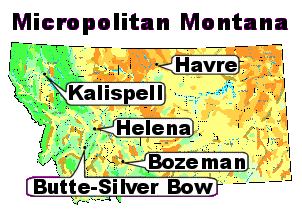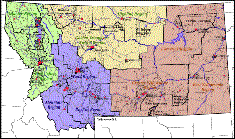Sohodojo Moves to Northcentral Montana
 Visitors to the Sohodojo web site know that this NARFI strategic partner is home of the nanocorp and the Small Is Good Business Revolution.
Visitors to the Sohodojo web site know that this NARFI strategic partner is home of the nanocorp and the Small Is Good Business Revolution.
When Sohodojo chose to leave North Carolina's sprawling Research Triangle Park for northcentral Montana, folks asked founders and research directors Jim Salmons and Timlynn Babitsky, "Why Havre?" In response, Sohodojo Jim and Timlynn would tell inquirers about the unique isolation factor, and how Havre has the critical mass of just enough public/private infrastructure to have all the stakeholders you need to get cooperative business and community development strategies going.
Havre and its surrounding region is a place that is 'just right', big enough but not too big, and sufficiently remote that it is not in the "gravitational pull" of any nearby urban metropolitan area. Havre and the Hi-Line (the regional name for the northcentral plains area of Montana) are, in short, perfect 'field study' locations (quite literally) for Sohodojo's research and social action agenda. And the opportunity to help articulate the mission and to launch the North American Rural Futures Institute (NARFI) was too significant to ignore.
Together, NARFI and Sohodojo are engaged in applied research and development exploring the opportunities and challenges for solo and family-based entrepreneurship within rural communities. This is a perfect time for such a unique partnership to develop future-oriented innovations in rural small business.
In the emerging Network Economy, connection and value-contribution are more important than geographic location. With today's communication and transportation technologies, entrepreneurial small businesses can transcend their rural locations from a business opportunity standpoint without folks having to give up the rural lifestyles they enjoy. Contrary to the nay-sayers predicting the death of rural small towns and rural small business, there is an indomitable spirit among rural citizens that will shape a new role in the national economy for rural areas and their extended networks of entrepreneurs and small businesses.
Micropolitan Montana - Even the U.S. Census Bureau Sees It Coming!
You don't have to take our word for it anymore when it comes to recognizing that Small Is Good, and that some interesting things are brewing in rural America. And these healthy new brews are not just scaled-down versions of what's happening in urban areas.
The U.S. Census Bureau now recognizes micropolitan areas along with the more familiar metro variety.
And, yes, Havre, Montana is one of them! Here's our listing:
25660 Havre, MT Micropolitan Statistical Area 25660 30041 Hill County, MT
| Montana's Regional Economies | |

|
|
| Montana is a leader in recognizing the importance and potential of regional economies. The map above is part of the Creating Montana's Economic Roadmap for the Future that is a proposal under consideration by the Board of Regents of the State University System. |
found in the bureau's current list of Micropolitan Statistical Areas and Components. Havre is one of five micropolitan areas in Montana. Even our state capital, Helena, is in the ranks along with Bozeman, Butte-Silver Bow, Havre, and Kalispell.
The U.S. Census Bureau's standard definitions of metropolitan areas were first issued in 1949 under the designation "standard metropolitan area" (SMA). The term went through a long series of subtle terminological tweaks over the next four decades. The term "core based statistical area" (CBSA) became effective in 2000 and refers collectively to metropolitan and the newly designated micropolitan statistical areas. (Follow this link for more on the Census Bureau's metro/micro CBSA classification system. See this bulletin for the Office of Management and Budget's official declaration of the new micropolitan definition.)
For the U.S. Federal government's purposes, a Micropolitan Statistical Area is a Core Based Statistical Area associated:
"...with at least one urban cluster that has a population of at least 10,000, but less than 50,000. The Micropolitan Statistical Area comprises the central county or counties containing the core, plus adjacent outlying counties having high degree of social and economic integration with the central county as measured through commuting."
(From 2000 Metropolitan and Micropolitan Statistical Area Standards,
page 12 in this PDF document.)
Ironically, note in the above definition that the Federal government thinks that commuting – to those increasingly scarce stable, full-time jobs – is the best indicator of regional social and economic integration. Maybe commuting made sense as an integration indicator in the 50's. But not today, not in the era that Richard Florida has characterized as the rise of the Creative Class.
-- Page 1 of 3 --
